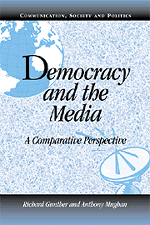Book contents
- Frontmatter
- Contents
- List of Contributors
- Acknowledgments
- 1 The Media in Democratic and Nondemocratic Regimes: A Multilevel Perspective
- 2 The Media and Politics in Spain: From Dictatorship to Democracy
- 3 Institutional Incapacity, the Attentive Public, and Media Pluralism in Russia
- 4 Democratic Transformation and the Mass Media in Hungary: From Stalinism to Democratic Consolidation
- 5 The Modernization of Communications: The Media in the Transition to Democracy in Chile
- 6 Media Influence in the Italian Transition from a Consensual to a Majoritarian Democracy
- 7 The United States: News in a Free-Market Society
- 8 Japan: News and Politics in a Media-Saturated Democracy
- 9 The Netherlands: Media and Politics between Segmented Pluralism and Market Forces
- 10 Great Britain: The End of News at Ten and the Changing News Environment
- 11 Germany: A Society and a Media System in Transition
- 12 The Political Impact of the Media: A Reassessment
- References
- Index
10 - Great Britain: The End of News at Ten and the Changing News Environment
Published online by Cambridge University Press: 05 June 2012
- Frontmatter
- Contents
- List of Contributors
- Acknowledgments
- 1 The Media in Democratic and Nondemocratic Regimes: A Multilevel Perspective
- 2 The Media and Politics in Spain: From Dictatorship to Democracy
- 3 Institutional Incapacity, the Attentive Public, and Media Pluralism in Russia
- 4 Democratic Transformation and the Mass Media in Hungary: From Stalinism to Democratic Consolidation
- 5 The Modernization of Communications: The Media in the Transition to Democracy in Chile
- 6 Media Influence in the Italian Transition from a Consensual to a Majoritarian Democracy
- 7 The United States: News in a Free-Market Society
- 8 Japan: News and Politics in a Media-Saturated Democracy
- 9 The Netherlands: Media and Politics between Segmented Pluralism and Market Forces
- 10 Great Britain: The End of News at Ten and the Changing News Environment
- 11 Germany: A Society and a Media System in Transition
- 12 The Political Impact of the Media: A Reassessment
- References
- Index
Summary
Television and the press in Britain appear to exemplify the two extremes of a continuum from nonpartisan to partisan or from impartial to partial. Television continues to be the principal source of information about politics for most people in Britain, despite the enormous changes that have occurred in the country's broadcast media landscape in the past decade. Television news also continues to be the most trusted and most credible source of information at election time. Newspapers reach a much smaller audience, and they also offer a far more partisan perspective on politics. At election time, the tabloids in particular are known to be screamingly partisan. One of the most notorious examples of this was the front page of the Sun, the country's most popular tabloid, on election day in 1992. With the head of Labour Party leader Neil Kinnock pictured inside a light bulb, the Sun asked: “If Kinnock Wins Today, Will the Last Person to Leave Britain Please Turn Out the Lights?”
Developments in the 1990s may have signaled some movement away from both ends of this continuum toward the center. In the press, these developments include the remarkable flipping of newspaper partisanship from Conservative dominant to Labour dominant in the 1997 election. In addition, on television, viewers have many more channels nowadays, and this provides more opportunities for people either to tune out of politics altogether or to follow news continuously on dedicated news channels.
- Type
- Chapter
- Information
- Democracy and the MediaA Comparative Perspective, pp. 343 - 374Publisher: Cambridge University PressPrint publication year: 2000
- 11
- Cited by



